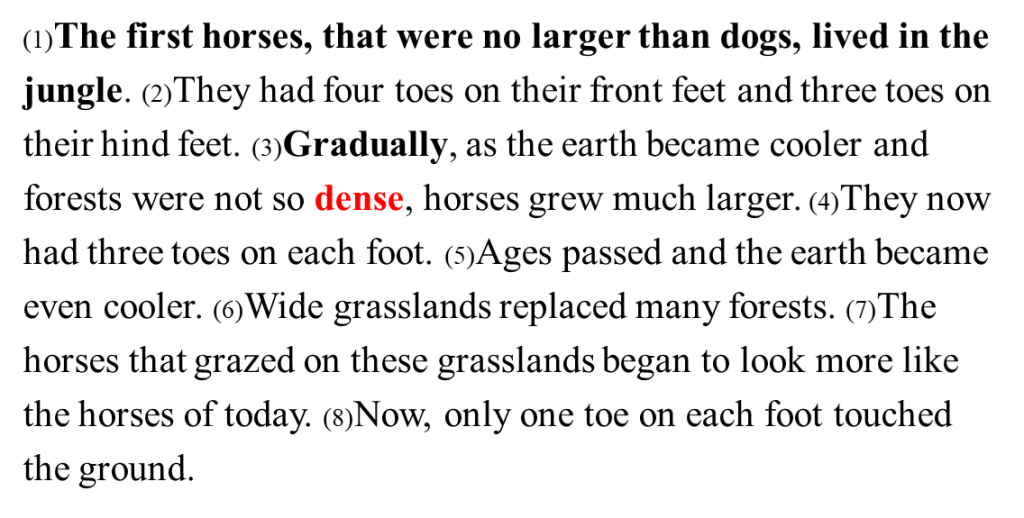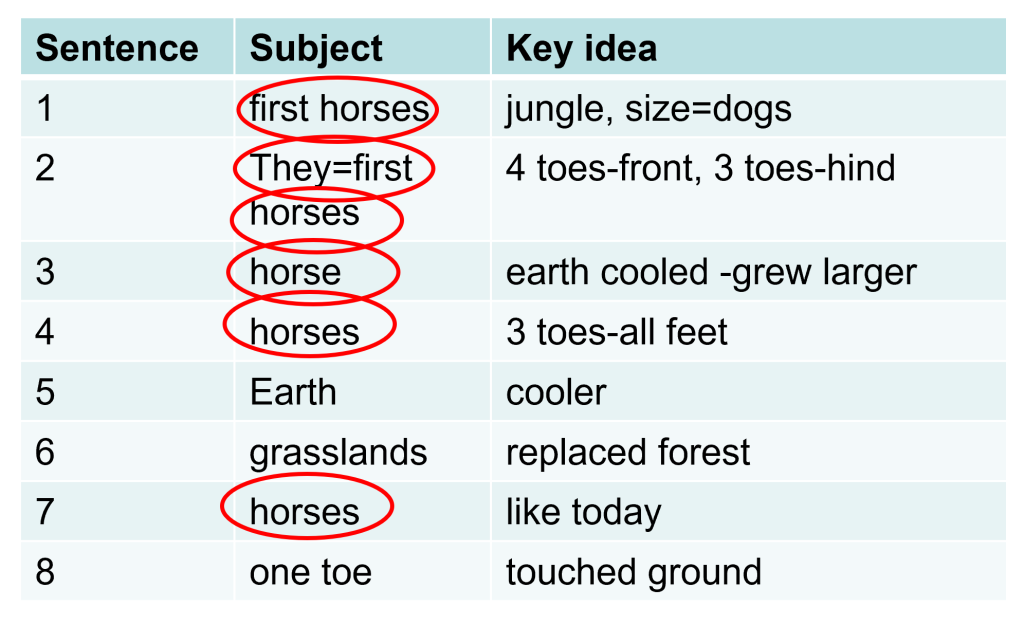
The key information within a paragraph, and arguably a whole story, is often contained within a few sentences. Similarly, not all words have equal value in terms of making sense of individual sentences. Therefore, determining the key sentences and the key words within sentences is a critical skill of an efficient reader.
The following (presented by Morel & Burch at the IDA 2024 conference) is an effective strategy for developing students’ comprehension at the sentence level. The strategy can be applied to any text, both fiction and non-fiction, and in any subject area.
Step 1
Choose one paragraph from the chosen text.
Then choose a key sentence from the passage that reflects the key focus of the passage and scramble the word order.
The rationale for doing this unscrambling activity is that it:
- Provides a purpose or focus for doing the activity.
- You can use it as an opportunity to define, discuss or review key vocabulary.
- It helps develop students’ knowledge of syntax – how we arrange words and phrases and the parts of the speech.
- It helps develop fluency as students are required to re-read the vocabulary multiple times as they build up the sentence.
- And it can be used as a starting point to find out students’ current knowledge of the topic.
However, just keep in mind that you don’t need to do this step if you don’t think it would be useful or relevant for your students – or because you simply don’t have time.
It can be useful to put each word onto individual cards so students can manipulate and keep rearranging the words.
You can also choose whether you signal the first word in the sentence by adding a capital and the last sentence by adding a full stop – or not.
The sentence you choose also doesn’t need to be an exact replication of the sentence from the passage. Remember the more clauses within a sentence the more difficult it will be to unscramble.
Example scrambled sentence:

Use the following steps to unscramble the sentence:
- Discuss/review the meaning of any key word(s) – in this example it was ‘dense’.
- Ask who or what is the subject, which means the student is looking for a noun. In this example, it could have been ‘jungle’ or ‘horses’, but given that ‘jungle’ has a full stop after it, it means it must be ‘horses’. In this example, the student would also need an article in front of ‘horses’ – in this example ‘the’.
- Next have the students read those two words – The horses.
- Then ask, “What did the subject do?” In another words, the students have to identify the verb. In this example it is ‘lived’.
- The students read the three words now in the sentence – The horses lived.
- Continue to ask questions that are relevant to the particular sentence – where, when, how many, etc. In this example, you could ask, “Where did the horses live?” (jungle).
- For this sentence, the next step would be to add in a preposition and an article and in front of ‘jungle’ for the sentence to make sense.
- The students rereads the sentence to-date – The horses lived in the jungle.
- The repeated rereading not only helps build fluency but is a useful process in helping students understand whether the words and word order they have selected make sense.
- Lastly ask the students to look for adjectives to add to nouns and/or adverbs to add to verbs. In this example: The first horses lived in dense forests.
- You could then have students reread the sentence with different expressions.
- An interesting additional activity would be to change the word order and see how that impacts on the meaning of the sentence.
The dense horses lived in the first forest. The dense forest lived in the first horses.
Step 2
The next step is designed to help students determine the gist of each sentence in the paragraph.
Example paragraph taken from the Cracking the ABC Code Reading for Comprehension Level 4 Reading book:

Reading for Comprehension Level 4
For each sentence, students:
- Read the sentence.
- Circle the subject.
- Underline the 2 or 3 key words. Keep in mind that if it is a complex sentence there may be several key ideas so if there is more than one key idea the key words related to these ideas would need to be underlined.
- Add this information to the graphic organiser (see example below).
- As a part of this process, students need to identify any pronoun referents and record this on the graphic organiser
- Next students use the graphic organiser to determine the key subject and the one overarching key idea – horses.
- It is important that for this step and the following steps that students rely purely on the information written in the graphic organiser as this will stop students from copying from the passage and to really reflect on the key information – Horses changed as the earth cooled.
Example Graphic Organiser

Step 3
The last step is for students to expand on their nutshell sentence using the graphic organiser.
Support students in this step by asking where, when or why questions as relevant to the information contained in the passage.
Lastly, help students correct for punctuation, spelling and grammar. I think this is an important step and I suggest not giving any information about punctuation, spelling or grammar while students are constructing the expanded nutshell sentence so you can really use this as a teaching/learning opportunity.
The first horses became larger and lost a toe as the earth cooled and grasslands replaced forests.
Reference
Morel, A., & Burch, J. (2024). The sentence as a vehicle to comprehension. Session IPPO2-24 International Dyslexia Association Conference, October, 2024.
